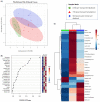The Effects of Live Transport on Metabolism and Stress Responses of Abalone (Haliotis iris)
- PMID: 34822406
- PMCID: PMC8623598
- DOI: 10.3390/metabo11110748
The Effects of Live Transport on Metabolism and Stress Responses of Abalone (Haliotis iris)
Abstract
The New Zealand abalone industry relies mostly on the export of processed products to distant Asian markets, notably China. Over the past five years, live export of high quality abalone from New Zealand has proven successful. However, transport of live animals is associated with multiple stressors that affect survival and meat quality at the end of the transport phase. Better understanding of transport-derived stress is needed to improve transport conditions and recovery at destination to ensure high product quality and safety throughout the supply chain. To this end, we applied an untargeted GC-MS-based metabolomics approach to examine the changes in metabolite profiles of abalone after a 2-day transport event and subsequent water re-immersion for 2 days. The results revealed alterations of many metabolites in the haemolymph and muscle of post-transported abalone. Decreased concentrations of many amino acids suggest high energy demands for metabolism and stress responses of transported abalone, while increases of other amino acids may indicate active osmoregulation and/or protein degradation due to oxidative stress and apoptosis. The accumulation of citric acid cycle intermediates and anaerobic end-products are suggestive of hypoxia stress and a shift from aerobic to anaerobic metabolism (resulting from aerial exposure). Interestingly, some features in the metabolite profile of reimmersed abalone resembled those of pre-transported individuals, suggesting progressive recovery after reimmersion in water. Evidence of recovery was observed in the reduction of some stress biomarkers (e.g., lactic acid, succinic acid) following reimmersion. This study revealed insights into the metabolic responses to transport stress in abalone and highlights the importance of reimmersion practices in the supply chain of live animal exports.
Keywords: GC–MS; abalone; live transportation; metabolomics; resuscitation; stress responses.
Conflict of interest statement
The authors declare no conflict of interest.
Figures


References
-
- Roodt-Wilding R. Abalone ranching: A review on genetic considerations. Aquac. Res. 2007;38:1229–1241. doi: 10.1111/j.1365-2109.2007.01801.x. - DOI
-
- FAO Global Aquaculture Production 1950–2019 (Online Query) [(accessed on 14 April 2021)]. Available online: http://www.fao.org/fishery/statistics/global-aquaculture-production/quer....
-
- FAO Global Capture Production 1950–2019 (Online Query) [(accessed on 14 April 2021)]. Available online: http://www.fao.org/fishery/statistics/global-capture-production/query/en.
-
- Seafood New Zealand New Zealand Seafood Exports—Report 7—Seafood Exports by Product typ Caldendar Year to December 2020 (Provisional) [(accessed on 17 September 2021)]. p. 115. Available online: https://www.seafood.org.nz/fileadmin/documents/Export_data/20.12.7.pdf.
Grants and funding
LinkOut - more resources
Full Text Sources
Miscellaneous

